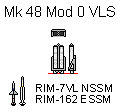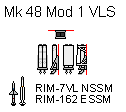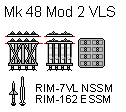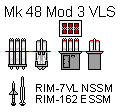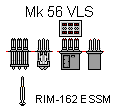Difference between revisions of "Mk 48 VLS"
Acelanceloet (talk | contribs) |
(No difference)
|
Revision as of 09:16, 7 April 2018
History
The Mk 48 VLS was first fitted on the Dutch Karel Doorman class frigates. The system was designed to fire the NATO Sea Sparrow Missile (NSSM), replacing the Mk 29 GMLS launcher on earlier ships. The Mk 48 VLS was build up from 2,6 or 16 -cell modules. The Mk 48 was an more compact system for ships that required an VLS system but no large missiles. Initially, 4 different versions were build:
- Mk 48 Mod 0. 2 cell on-deck installation with an upwards exhaust, used since 1992 on the Halifax class and Murasame class.
- Mk 48 Mod 1. 2 cell on-bulkhead installation with the exhaust vent at the bottom, venting to the side. Used since 1991 on the Karel Doorman class.
- Mk 48 Mod 2. 16 cell belowdeck installation with an upwards exhaust. Used since 1992 on the KDX-I class and the Hydra class.
- Mk 48 Mod 3. 6 cell installation which is part of the STANFLEX system. Used on ships that support the STANFLEX system since 1992.
After in 2005 ESSM appeared, an modification to the Mk 48 VLS was build. This system was initially called DP-48, most likely referring to dual pack. This modification allowed 2 ESSM canisters to replace a single NSSM canister in the Mk 48 system. Only the Mod 3 variant of this DP-48 was actually comissioned into active service as the Mk 56 VLS, which made the Mk 48 STANFLEX module an 12 missile launcher. Most likely all Mk 48 units can be rebuild or modified to DP-48, however as far as is known this has not been done. It is likely an modification to fire ESSM from the existing NSSM canister size has been done to some of the Mk 48 installations, similar to how ESSM can now be fired from the Mk 29 GMLS
Used on
- Karel Doorman class
- Halifax class
- Murasame class
- KDX-1 class
- Hydra class
- Niels Juel class
- Iver Huitfeldt class
- Absalon class
- Flyvefisken
Affiliated systems
Part description
The drawing has the below deck installation drawn in, which requires covering for use on a finished Shipbucket drawing. Approximate deck levels around the launcher are drawn in red, the height of the covering that should hide structural parts of the launcher is drawn in green.
